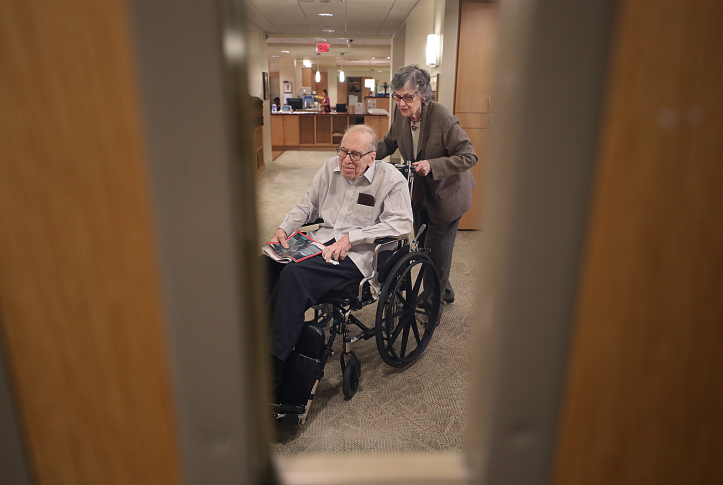1. Eliminate the homebound requirement in the Medicare home health benefit and provide equitable access to existing in-home services. With limited exceptions, Medicare reimburses in-home health services only if beneficiaries are confined to the home. In the short term, the Centers for Medicare and Medicaid Services (CMS), the federal agency that administers the Medicare program, could promote more equitable access to the home health benefit. For example, CMS could ensure that its prospective payment system for home health does not restrict access to medically complex beneficiaries and underserved populations2 and to others who are qualified, like those without a prior hospitalization.3 CMS also could provide more accessible information on benefits, rules, and appeal rights. Further, the agency could encourage testing in the ACO REACH model, a newly redesigned, equity-focused, value-based payment model that permits accountable care organizations (ACOs) to waive the Medicare homebound requirement for access to home health services, and could add similar flexibility to other models.4
An interim option for CMS is to offer greater flexibility in considering who is homebound.5 Over the longer term, Congress could eliminate the homebound requirement and add other improvements to the home health benefit.
2. Incentivize Medicare Advantage organizations to offer broader supplemental benefits to beneficiaries and their caregivers, like food and respite care, which allows caregivers a short-term break. Half of all Medicare beneficiaries are enrolled in Medicare Advantage plans. In the short term, CMS could use regulatory and payment mechanisms to encourage Medicare Advantage organizations to offer more comprehensive supplemental benefits, such as respite and adult day care, and nonprimarily health-related benefits like food and nonmedical transportation, to reduce caregiver burden and families’ out-of-pocket expenses for home-based care.6 CMS also could incentivize plans to offer additional benefits that address the nonmedical drivers of health, especially in areas with higher levels of underserved populations.
Over the longer term, Congress could expand eligibility for special supplemental benefits beyond the statutorily defined chronically ill population. This expansion would make more beneficiaries eligible for nonmedical benefits like meals and groceries, which may positively affect health outcomes.7 Expanded eligibility could include those with low-income subsidy eligibility who can currently receive nonmedical supplemental benefits in plans offered under the Medicare Advantage Value-Based Insurance Design Model.8
3. Increase opportunities for ACOs to provide benefits that support beneficiaries and their caregivers at home. Through the current ACO REACH Model, policymakers can learn from testing whether care management home visits prevent hospitalizations or whether waiving the Medicare homebound requirement improves access to home health services.
Additionally, the 2023 physician fee schedule offers incentives for new ACOs in the Medicare Shared Savings Program, one of CMS’s original value-based alternative payment models, to receive funds to address the social needs of people with Medicare that could help underserved beneficiaries and caregivers at home.9 Some Medicare ACOs already offer services that help caregivers manage beneficiaries’ care like case management, health and functional assessments, mobile technologies, and 24/7 clinical support. Over the longer term, the annual physician fee schedule could encourage more ACOs to provide other services that support beneficiaries and caregivers at home.
4. Use the annual Medicare physician fee schedule to increase beneficiary and caregiver services in traditional Medicare, in-home support services, and education and training. An example of a recent service, added by the 2023 fee schedule, is coverage of some dental services because they are inextricably linked to the clinical success of an otherwise covered medical service.10 Accordingly, CMS could propose other services that help beneficiaries and caregivers at home.
Use of currently available codes for providing services, like assessments of caregiver health risk and their ability to care for a beneficiary with dementia, could be increased through greater provider education and awareness. These caregiver-specific services may not be sufficiently publicized in existing provider resources such as the Medicare Learning Network or tip sheets.11 New codes finalized for 2024, including the code to provide payment when practitioners train and involve caregivers to support patients with certain diseases or illnesses (e.g., dementia) in carrying out a treatment plan,12 require provider outreach and education to ensure their use. In addition, agencies also could ensure caregivers receive the required training. For example, home health agency conditions of participation require caregiver preparedness training.13
5. Use the CMS Innovation Center, which tests new payment and delivery models, to assess the quality and cost of in-home services to accelerate Medicare’s future coverage of these benefits. For example, the CMS Innovation Center has recently developed the GUIDE Model, a dementia care model that tests patient- and family-centered care, including the needs of caregivers, over a period of years.14 The model includes respite care but could include other supports for family caregivers. Caregiver supports could be tested more broadly beyond dementia, in other models as well.
6. Expand Medicare coverage of additional benefits for beneficiaries and their caregivers. Traditional Medicare provides little to no coverage of stand-alone benefits like home health aides, personal care services, adult day care, mental health services for caregivers, and home safety modifications like grab bars. Health benefits for beneficiaries like vision, dental, and hearing that could help ease the burden on caregivers are also generally not covered, nor are nonmedical benefits like meals and transportation15 that help support home-based care. One short-term strategy is to ensure that community-based organizations are fully funded and their social benefits are accessible to all Medicare beneficiaries. Over the longer term, expanding such benefits in traditional Medicare would require congressional action.
Provide Financial Support for Family Caregivers
